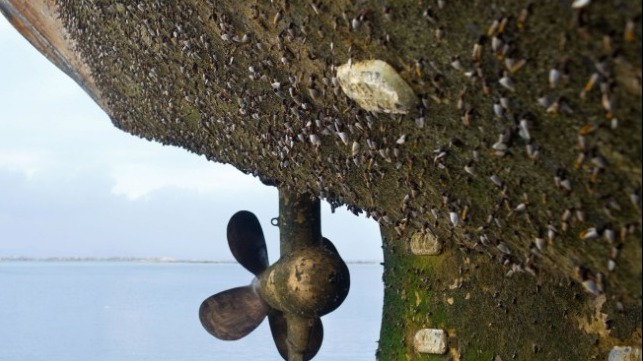Study: Biofouling Poses a Unique Risk to Antarctica

In a new study published Monday, a group of researchers from the University of Cambridge and the British Antarctic Survey report that Antarctica is at risk of experiencing some of the same marine invasive species problems found in large seaports around the world. Ship traffic is on the rise around the frozen continent, and each vessel carries the potential to deliver new, foreign marine organisms into isolated Antarctic ecosystems.
The authors noted that Antarctica is connected to all regions of the globe via shipping activity. Fishing, tourism, research and supply ships transit to the continent from more than 1,500 ports around the world. Based on satellite AIS data of ship traffic passing south of 60 degrees S, vessels were found to sail most frequently between Antarctica and ports in South America, Northern Europe, and the western Pacific Ocean.
While some of these vessels stop off at five "gateway" ports and get their hulls cleaned before traveling further south, many do not - bringing new species of mussels, barnacles, crabs and algae with them.
“The species that grow on the hull of a ship are determined by where it has been. We found that fishing boats operating in Antarctic waters visit quite a restricted network of ports, but the tourist and supply ships travel across the world," said lead author Arlie McCarthy, a researcher at the University of Cambridge's Department of Zoology. “We were surprised to find that Antarctica is much more globally connected than was previously thought. Our results show that biosecurity measures need to be implemented at a wider range of locations than they currently are. There are strict regulations in place for preventing non-native species getting into Antarctica, but the success of these relies on having the information to inform management decisions."
The researchers said that they are particularly concerned about the transport of species from the Arctic. These species are already adapted to the cold, and they could make the journey on tourist or research ships, which often spend the northern summer in the Arctic and the southern summer in the Antarctic.
Some classes of marine invasive species would be entirely new to Antarctica and could be disruptive to its ecosystems. Mussels would be entirely new and would have no competitors if they were accidentally introduced. Shallow-water crabs are a type of predator that Antarctic creatures have never encountered before - and would not be prepared to fend off. A new predator in an isolated environment can have detrimental effects; for example, the introduction of rats on an island bird sanctuary, like South Georgia or Lehua, can decimate seabird populations.
Large krill fisheries in the Southern Ocean could also be disrupted by invasive species. Krill is a major component of the fish food used in the aquaculture industry, and krill oil is sold widely as a dietary supplement.
“Invasive, non-native species are one of the biggest threats to Antarctica’s biodiversity - its native species have been isolated for the last 15-30 million years. They may also have economic impacts, via the disruption of fisheries,” said Professor David Aldridge in the Department of Zoology at the University of Cambridge, a co-author of the report.
The study points towards the need for new biosecurity measures for Antarctica-bound vessels - particularly as ocean temperatures are on the rise, making frigid regions a bit more habitable for species from lower latitudes. Control measures for invasives may need to extend beyond the current focus on nearby "gateway" ports (Ushuaia, Punta Arenas, Hobart, Christchurch and Cape Town), said coauthor Professor Lloyd Peck, a marine biologist at British Antarctic Survey.
"This is the last place in the world where we don't have marine invasive species," McCarthy told the BBC. "So we have an opportunity to protect it."
